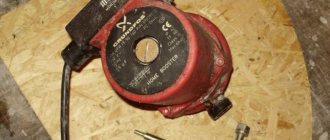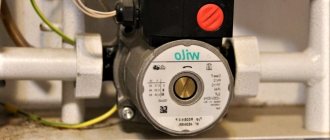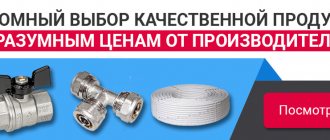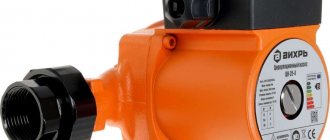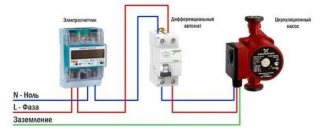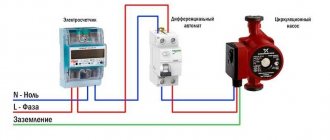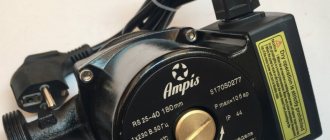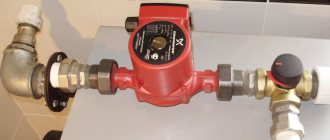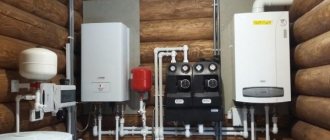Uniform distribution of the coolant inside the pipeline and radiators is ensured by using a pump for the heating boiler. The device maintains the required pressure in the system, helping the fluid overcome a difficult path. You can install the circulation pump yourself if you read the instructions and technical design of the device.
Circulation pump in a gas boiler
The circulation pump in the design of a gas boiler accelerates the coolant through the heating system, due to which the coolant cools in the system more slowly and returns to the boiler in a “heated” form. Since heating in the boiler occurs to a certain temperature, the next heating cycle of the coolant will be shorter. This results in lower gas consumption and faster water heating cycles (higher efficiency).
It is believed that hydraulic heating systems do not require the installation of circulation pumps, however, it will not interfere at all in old heating systems with large diameter pipes.
By purchasing a gas boiler with a circulation pump in the design, you no longer need to install a separate circulation pump in the heating system.
Step-by-step instructions for assembling and installing the pump
After purchasing the device and choosing the location for its installation, it is necessary to carry out assembly and installation. It is first necessary to install ball valves on both sides of the pump, and install a mud trap in front of the unit to retain scale, dirt, and abrasive particles. The upper part of the bypass must be equipped with an air valve.
Assembling and connecting the pump to the heating boiler is carried out in the following sequence:
- Before installation, drain the liquid from the system. For complete cleaning, you need to fill it with coolant and drain it, then repeat this procedure a couple more times.
- Install the pump into the system.
- After installation, all connections must be carefully sealed.
- Fill the system with liquid. Remove excess air.
- Connect the device to the electrical network.
The number of circulation devices required in the system depends on the length of the pipeline.
conclusions
- The circulation pump in the design of a gas boiler improves the operation of heating systems, both single-circuit and double-circuit heating boilers.
- The circulation pump is especially relevant in the design of a wall-mounted boiler.
©Obotoplenii.ru
Other articles in the section: Gas boiler
- Advantages of a condensing heating boiler
- Which gas floor-standing boiler is better and why
- What is a hydraulic block of a gas boiler
- Combustion chambers of a gas boiler
- Installation of a gas boiler: preparatory work for installing a gas heating boiler on the wall
- How to flush the heat exchanger of a gas boiler
- Heat exchangers for gas boilers: differences in materials
Hydraulic separator
If there is a need to install an additional pump, then another device must be included in such a heating system - a hydraulic separator. In the list of terms used, a hydraulic separator can also be called an anuloid or a hydraulic arrow.
Operating principle of hydraulic separator
Such devices are recommended for use in heating systems where the coolant is heated using long-burning boilers. The fact is that the heating devices in question can operate in several phases (fuel ignition, combustion process and attenuation), and for each of these phases it is necessary to maintain a certain combustion mode.
Installing a hydraulic needle in the heating system allows you to create a certain balance in the operation of heat and warming up the system. The anuloid itself is made in the form of a pipe with four outlet pipes. The main functions of such a device include:
- Automatic removal of accumulated air;
- Collecting sludge particles (works as a dirt trap).
Note! From these characteristics it can be understood that the hydraulic separator is considered an important device in the heating system, so it must be installed without fail if there is a pump.
Hydraulic separator in the heating system
Heating in a private house performs many functions that must be implemented regardless of coolant flow and possible pressure drops in the pipelines. It is quite difficult to achieve efficient operation of the system, because the liquid enters the pipeline circuits from one source of thermal energy - the boiler, which will ultimately lead to unbalanced heating. To prevent such situations, the hydraulic separator serves; it performs the function of decoupling.
The feasibility of using automatic and manual switching between two boilers
Let's consider the following five options with various units in conjunction with an electric boiler, which is in reserve and must turn on at the right time:
- Gas + Electric
- Firewood + Electric
- Liquefied gas + Electro
- Solar + Electro
- Pellet (granular) + Electro
Pellet and electric boiler
The combination of connecting two boilers - a pellet and an electric boiler - is best suited for automatic switching on and manual switching is also allowed.
A pellet boiler may stop because it has run out of fuel pellets. It got dirty and wasn't cleaned. The electric one must be ready to turn on to replace the stopped boiler. This is only possible with automatic connection. Manual connection in this option is only suitable when you permanently live in a house where such a heating system is installed.
Diesel boilers fuel and electricity
If you live in a house with such a system for connecting two heating boilers, a manual connection is quite suitable for you. The electric boiler will operate as an emergency boiler in case the boilers fail for some reason. They didn’t just stop, they broke down and require repairs. Automatic switching is also possible as a function of time. An electric boiler can operate in tandem with liquefied gas and a solar boiler at a night rate. Due to the fact that the night tariff is cheaper per 1 kW/hour than 1 liter of diesel fuel.
Combination of electric boiler and wood boiler
This combination of connecting two boilers is more suitable for automatic connection and less suitable for manual connection. A wood boiler is used as the main one. It heats the room during the day, and turns on the electricity to add heat at night. Or if you are not living in the house for a long time, an electric boiler maintains the temperature so as not to freeze the house. Manual operation is also possible to save electricity. The electric boiler will turn on manually when you leave and turn off when you return and start heating the house using a wood-fired boiler.
Combination of gas and electric boilers
In this combination of connecting two boilers, the electric boiler can act as both a backup and a main one. In this situation, a manual connection scheme is more suitable compared to an automatic one. The gas boiler is a proven and reliable unit that can operate for a long time without breakdowns. At the same time, connecting an electric boiler to the system for backup in automatic mode is impractical. If the gas boiler fails, you can always manually turn on the second unit.
Selecting the location for inserting the device into the system
The installation of the circulation pump is supposed to be in the area immediately after the heat generator, not reaching the first branch line. The chosen pipeline does not matter - it can be either a supply or a return line.
Where can I put the pump?
Modern models of household heating units, made of high-quality materials, can withstand temperatures of a maximum of 100 °C. However, most systems are not designed for higher heating of the coolant.
Its performance will be equally effective on both the supply and return branches.
- The density of water when heated to 50 °C is 987 kg/m3, and at 70 degrees – 977.9 kg/m3;
- The heating unit is capable of generating hydrostatic pressure of 4-6 m of water column and pumping almost 1 ton of coolant per hour.
From this we can conclude: the insignificant difference of 9 kg/m 3 between the statistical pressure of the moving coolant and the return does not affect the quality of space heating.
Are there exceptions to the rules?
As an exception, inexpensive solid fuel boilers - with a direct combustion type - can serve. Their device does not provide automation, so at the moment of overheating, the coolant begins to boil.
Problems begin to arise if the electric pump installed in the supply line begins to fill with hot water and steam.
The coolant penetrates through the housing with the impeller and the following occurs:
- Due to the action of gases on the impeller of the pumping device, the efficiency of the unit decreases. As a result, the coolant circulation rate coefficient is significantly reduced.
- An insufficient amount of cold liquid enters the expansion tank located near the suction pipe. The overheating of the mechanism increases and even more steam is formed.
- A large amount of steam entering the impeller completely stops the movement of warm water along the line. Due to the increase in pressure, the safety valve is triggered. Steam is released directly into the boiler room. An emergency situation is being created.
- If the firewood is not extinguished at this moment, the valve will not be able to cope with the load and an explosion will occur.
Installation diagram
In practice, two schemes for installing a circulation pump are used in a single-pipe and two-pipe heating system. Before carrying out installation work, you must carefully study the attached instructions. At the preparatory stage of work, water is drained from the system and the pipes are cleaned of contamination by additional pumping of liquid. The pump is installed according to the attached diagram, then coolant is poured into the circuit and the unit is turned on.
As we have already said, it is best to install the pump on the return side using a tap or, as it is also called, a bypass. Such a device is necessary to shut off the water and replace the pump in case of breakdown. The diameter of the outlet pipe should be smaller than that of the central pipeline.
Installation diagram of an additional pump in the heating system
At each edge of the bypass, before entering and after exiting the pump, taps are installed for emergency shut-off of the coolant. Another valve is installed on the central line to direct the flow of liquid through the pump. Before entering the pumping equipment, a special filter is attached that will accumulate harmful particles in the water.
With warm floor
Note! In the “Warm Floor” system, the circulation pump is installed in a horizontal position after the mixing unit in the supply pipeline section. In some wiring schemes, several such devices are installed, each of which will pump liquid within one floor.
Installation diagram of the pump in the “Warm Floor” system
Rules for connecting to power supply
The circulation pump is powered. The connection is standard. It is recommended to install a separate power supply line with a surge protector.
To connect, you need to prepare 3 wires - phase, neutral and ground.
You can choose any of the connection methods:
- through a differential machine device;
- connection to the network together with an uninterruptible power supply;
- power supply to the pump from the boiler automation system;
- with thermostat regulation.
Many people wonder why complicate things, because connecting the pump can be done by connecting a plug to a wire. This is how the pumping device is plugged into a regular outlet.
However, experts do not recommend using this method due to the risk of unforeseen situations: there is no grounding and a safety device.
The first option is not difficult to assemble yourself. It is necessary to install an 8 A differential circuit breaker. The wire cross-section is selected based on the device rating.
In the standard scheme, the power supply is carried out to the upper sockets - they are marked with odd numbers, the load - to the lower ones (even numbers). Both phase and neutral will be connected to the machine, so the connectors for the latter are designated by the letter N.
To automate the process of stopping the circulation of the coolant when cooling to a certain temperature, an electrical circuit is used to connect the pump and thermostat. The second is mounted in the supply line.
At the moment when the water temperature drops to the specified value, the device disconnects the electrical supply circuit.
There are no difficulties in supplying electricity through an uninterruptible power supply; it has special connectors for this. A heat generator is also connected to them when there is a need to provide electricity.
If you choose the method of connecting the pump to the boiler control panel or automation, you will need good knowledge of the power supply system or the help of a professional.

